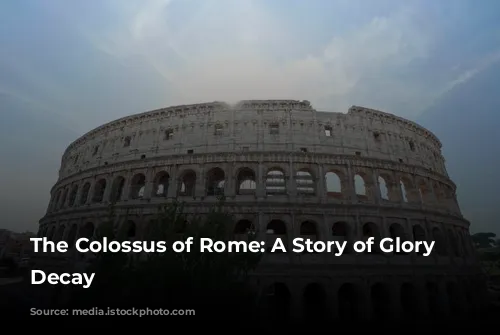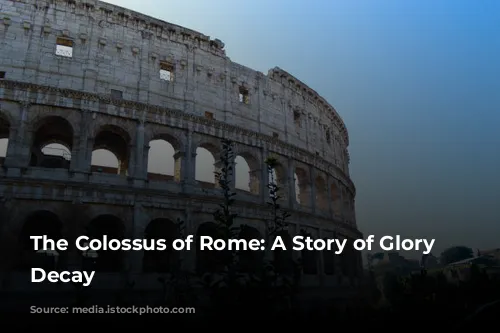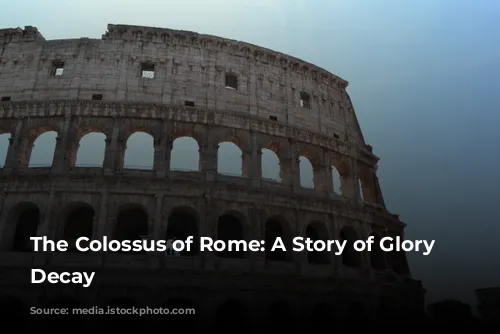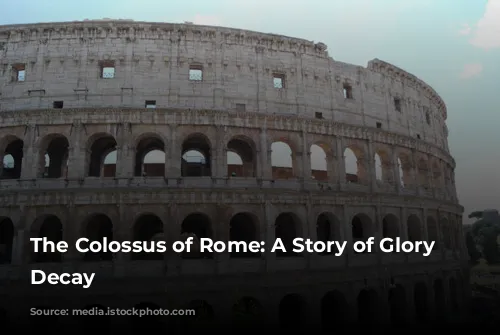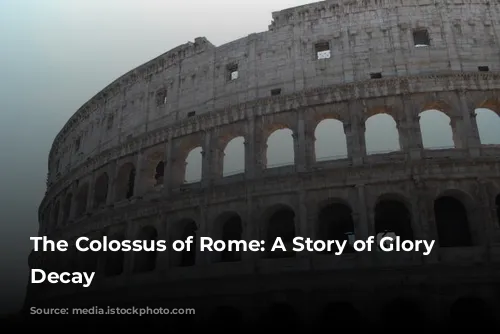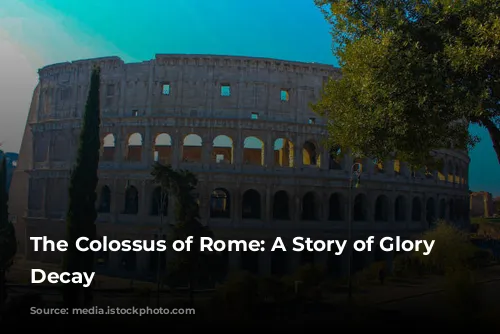The Colosseum, also known as the Flavian Amphitheatre, stands tall as the largest and most imposing amphitheatre in the Roman world, a testament to the grandeur of ancient Rome. Its construction, initiated by Emperor Vespasian of the Flavia dynasty, was completed by his son Titus, who inaugurated it in 80 AD.
This incredible structure, a marvel of Roman engineering, has captivated audiences for centuries. Its imposing facade, once adorned with gleaming white travertine stone, now presents a weathered yet enduring spectacle. The elliptical shape of the arena was meticulously designed to accommodate a large audience, and its four tiers, boasting eighty arches each, once housed magnificent statues.
The Colosseum’s opening ceremony was an extravagant spectacle, lasting an astounding one hundred days. The arena was transformed into a vast body of water, where incredible naumachias, reenactments of famous sea battles, captivated the crowds. The ceremony was a testament to the Roman’s love for grand displays, showcasing their mastery of engineering and their artistic talents.
But why is the Colosseum known by this name? The answer lies in a prophecy from the Venerable Bede, a medieval monk. His words, “Rome will exist as long as the Colosseum does; when the Colosseum falls so will Rome; when Rome falls so will the world,” have resonated through time. It’s believed that Bede derived the name “Colosseum” from the colossal statue of Emperor Nero, which stood near the amphitheatre. This statue, now vanished, was a testament to the emperor’s immense power, and its presence inspired the name that has become synonymous with the monument itself.
The Colosseum’s construction was a feat of engineering, a testament to the Roman mastery of the arch. This architectural marvel enabled the Romans to distribute the weight of massive structures with unparalleled efficiency, as demonstrated by the iconic Roman aqueducts. The Colosseum can be seen as a stack of aqueducts, each level seamlessly interconnected, supporting the grand structure.
A Glimpse into the Past: The Colosseum’s Transformation
While the Colosseum stands as a testament to ancient Roman engineering, the edifice we see today is only a skeletal remnant of its former glory. Time and human intervention have left their mark, leaving behind a haunting yet captivating image of the structure’s former grandeur.
Over the centuries, the Colosseum has been plundered for its precious materials. Marble, lead, and iron were extracted from the building, used to construct notable structures like the Barberini Palace, Piazza Venezia, and even St. Peter’s Basilica. The remnants of this plunder can still be seen in the form of holes in the columns, a stark reminder of the Colosseum’s transformation from a monumental structure to a source of building materials.
Despite its plundering, the Colosseum’s magnificence remains undeniable. It could accommodate up to seventy thousand spectators, each enjoying a clear view of the action from their designated seating. Entry was free for all Roman citizens, although seating was assigned based on social status, mirroring the practices of modern theaters.
The Colosseum provided its patrons with ingenious protection from the sun through its impressive “Velarium,” a massive linen tarp. This intricate system of ropes, winches, and wooden poles, operated by one hundred sailors from the Imperial fleet, was maneuvered with precision to provide shade during the events. This remarkable feat of engineering demonstrates the Romans’ dedication to comfort and spectacle, even in the midst of their grand amphitheatre.
The Colosseum: A Stage for Spectacle and Drama
Stepping into the Colosseum, the arena lies before you, a stage for a myriad of spectacles and dramas that once unfolded before eager spectators. The arena floor, once a mixture of brick and wood, has disappeared, revealing the cellars beneath, which housed the equipment used for the performances.
The two underground floors were a marvel of Roman technology, housing lifts and hoists with their counterweights. These mechanisms, the special effects of their time, were used to dramatically reveal animals and gladiators, bursting into the arena through trapdoors in a burst of white dust, captivating the audience with surprise and spectacle.
The Colosseum’s shows were not just entertainment; they were a powerful means of uniting citizens and their leader. These grand events, in addition to providing entertainment, served a symbolic purpose, fostering a sense of shared experience and distraction from political turmoil.
The Colosseum’s Shows: A Tapestry of Entertainment and Brutality
The Colosseum’s shows were diverse and captivating, drawing crowds from all walks of life. The morning hours were dedicated to “Venationes,” thrilling battles between exotic animals or between men and animals. These hunts, often used as a form of public execution, offered spectators a glimpse into the wild, pitting humans against nature’s ferocity.
The “Silvae,” a unique spectacle, featured meticulously crafted scenery, recreating a forest teeming with animals. This captivating display was not only a source of entertainment but also showcased the artistic talents of Roman painters and set designers.
The Colosseum also hosted less cruel and more unusual events, such as the performance of an elephant skilled in writing words in the sand with its trunk. This demonstration of animal intelligence captivated the audience, showcasing the Romans’ appreciation for diverse forms of entertainment.
The Gladiators: Stars of the Colosseum
However, it was the gladiators who truly captivated the Colosseum’s audience. The gladiatorial contests, held in the afternoon after a short break for the arena’s cleaning, were the highlight of the day.
The gladiators, often prisoners of war or volunteers seeking fame and fortune, were hailed as heroes by the crowds. Their arrival in the arena, accompanied by the blaring of trumpets and the beating of drums, was met with thunderous applause. They would pay homage to the emperor, saluting with the famous words “Ave Caesar, morituri te salutant” (Hail Caesar, those who are about to die salute you).
These skilled warriors, trained in a variety of combat styles, were a spectacle to behold. The audience watched with bated breath as gladiators from different categories faced off, their duels showcasing a fascinating blend of skill, strategy, and brutality.
The fate of the defeated gladiator rested in the hands of the emperor, who would decide their fate based on the roar of the crowd. A raised thumb meant life, while a lowered one signified death. These moments of suspense and drama underscored the Colosseum’s role as a stage for the ultimate clash of wills.
The Colosseum’s shows, while captivating, were undeniably brutal. This aspect of Roman culture, shocking to modern sensibilities, can be compared to the modern fascination with “splatter” cinema. However, the stark reality of the Colosseum’s brutality cannot be understated. The smell of blood and burnt flesh permeated the arena, a potent reminder of the violence that unfolded within its walls.
The Colosseum: A Legacy Enduring Through Time
With the decline of the Roman Empire, the Colosseum fell into disuse, becoming a source of materials for the construction of other structures. Its walls housed confraternities, hospitals, hermits, and even a cemetery. However, despite its decline, the Colosseum continued to hold a powerful hold over the public imagination.
Recognizing its historical significance, Pope Benedict XIV declared the Colosseum a sacred monument dedicated to the Passion of Christ. This move, placing a cross on a pedestal within the arena, transformed the Colosseum into a symbol of Christian martyrdom.
The Colosseum, once a stage for gladiatorial contests and animal hunts, became a place of pilgrimage and reflection. It was a reminder of the empire’s rise and fall, a symbol of the resilience of the human spirit in the face of adversity.
Today, the Colosseum stands as a testament to the grandeur of ancient Rome and the enduring fascination with its legacy. It serves as a reminder of the ingenuity and ambition of the Roman people, their love for spectacle, and the enduring power of history. For a modern tourist, visiting the Colosseum is truly to “see the ghost of old Rome floating over the places its people walk in,” as Charles Dickens eloquently put it.
